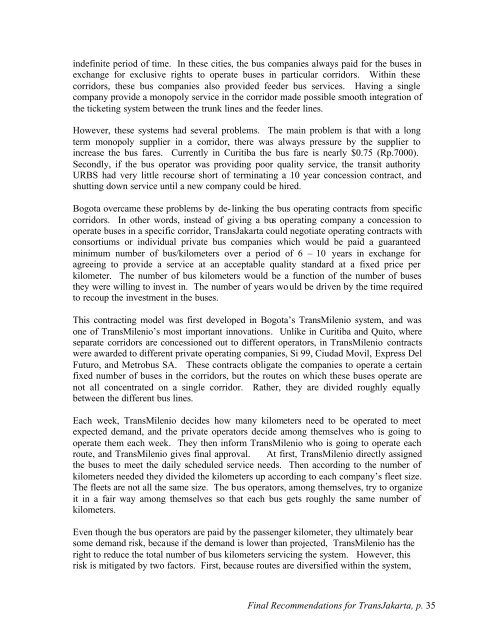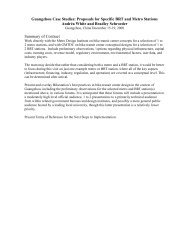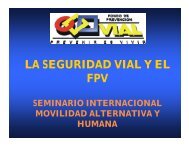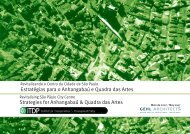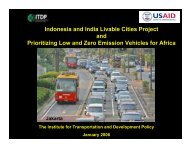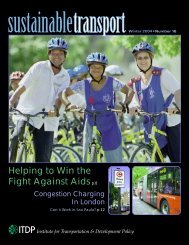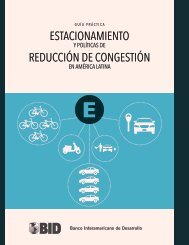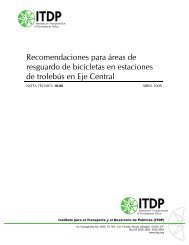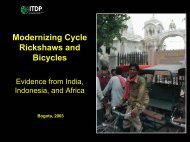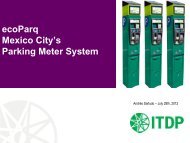Making TransJakarta a World Class BRT System - ITDP | Institute for ...
Making TransJakarta a World Class BRT System - ITDP | Institute for ...
Making TransJakarta a World Class BRT System - ITDP | Institute for ...
You also want an ePaper? Increase the reach of your titles
YUMPU automatically turns print PDFs into web optimized ePapers that Google loves.
indefinite period of time. In these cities, the bus companies always paid <strong>for</strong> the buses in<br />
exchange <strong>for</strong> exclusive rights to operate buses in particular corridors. Within these<br />
corridors, these bus companies also provided feeder bus services. Having a single<br />
company provide a monopoly service in the corridor made possible smooth integration of<br />
the ticketing system between the trunk lines and the feeder lines.<br />
However, these systems had several problems. The main problem is that with a long<br />
term monopoly supplier in a corridor, there was always pressure by the supplier to<br />
increase the bus fares. Currently in Curitiba the bus fare is nearly $0.75 (Rp.7000).<br />
Secondly, if the bus operator was providing poor quality service, the transit authority<br />
URBS had very little recourse short of terminating a 10 year concession contract, and<br />
shutting down service until a new company could be hired.<br />
Bogota overcame these problems by de-linking the bus operating contracts from specific<br />
corridors. In other words, instead of giving a bus operating company a concession to<br />
operate buses in a specific corridor, <strong>TransJakarta</strong> could negotiate operating contracts with<br />
consortiums or individual private bus companies which would be paid a guaranteed<br />
minimum number of bus/kilometers over a period of 6 – 10 years in exchange <strong>for</strong><br />
agreeing to provide a service at an acceptable quality standard at a fixed price per<br />
kilometer. The number of bus kilometers would be a function of the number of buses<br />
they were willing to invest in. The number of years would be driven by the time required<br />
to recoup the investment in the buses.<br />
This contracting model was first developed in Bogota’s TransMilenio system, and was<br />
one of TransMilenio’s most important innovations. Unlike in Curitiba and Quito, where<br />
separate corridors are concessioned out to different operators, in TransMilenio contracts<br />
were awarded to different private operating companies, Si 99, Ciudad Movil, Express Del<br />
Futuro, and Metrobus SA. These contracts obligate the companies to operate a certain<br />
fixed number of buses in the corridors, but the routes on which these buses operate are<br />
not all concentrated on a single corridor. Rather, they are divided roughly equally<br />
between the different bus lines.<br />
Each week, TransMilenio decides how many kilometers need to be operated to meet<br />
expected demand, and the private operators decide among themselves who is going to<br />
operate them each week. They then in<strong>for</strong>m TransMilenio who is going to operate each<br />
route, and TransMilenio gives final approval. At first, TransMilenio directly assigned<br />
the buses to meet the daily scheduled service needs. Then according to the number of<br />
kilometers needed they divided the kilometers up according to each company’s fleet size.<br />
The fleets are not all the same size. The bus operators, among themselves, try to organize<br />
it in a fair way among themselves so that each bus gets roughly the same number of<br />
kilometers.<br />
Even though the bus operators are paid by the passenger kilometer, they ultimately bear<br />
some demand risk, because if the demand is lower than projected, TransMilenio has the<br />
right to reduce the total number of bus kilometers servicing the system. However, this<br />
risk is mitigated by two factors. First, because routes are diversified within the system,<br />
Final Recommendations <strong>for</strong> <strong>TransJakarta</strong>, p. 35


